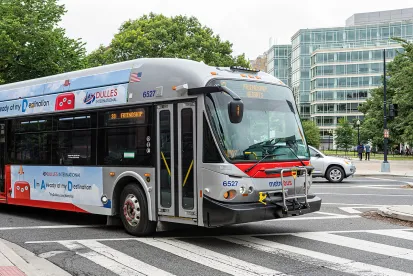Zero-emission bus (ZEB) technology has reached a stage where the whole-life cost of a ZEB fleet is broadly similar to that of an equivalent internal combustion engine (ICE) bus fleet. Although the operating costs of ZEBs are lower than those of their ICE equivalents, ZEBs require a higher initial investment, as well as mid-life replacements of batteries and other components. This means that financing ZEBs is a different proposition than financing ICE buses and, depending on the particular circumstances, innovative financing models are required. In this second GT Advisory of a two-part series, Greenberg Traurig’s Richard Hughes looks at potential financing models for ZEB fleets and associated infrastructure.
ZEB Financing
The first GT Advisory of this two-part series looked at some of the key considerations for the procurement of ZEBs. The procurement process is intrinsically linked to the selection and application of the appropriate financing model. A number of ZEB procurement financing models have emerged, ranging from “standard” asset finance models to more innovative structures.
Each ZEB procurement financing model separates the timing of the deployment of funds into three broad categories:
-
Initial expenditure: A degree of initial expenditure is required, with some financing models requiring significant investment amounts prior to commencement of the operational period of the assets. The scope and extent of the initial investment will have a fundamental impact on the overall payment profile of any bus fleet procurement;
-
Operating Phase: The amount of funds required for the operational phase will depend in large part on the scope and extent of the initial investment. From a high-level perspective, a greater investment at the outset may result in a more predictable and manageable payment profile during the operational phase; and
-
Disposal: Funds need to be reserved for costs associated with disposal. Disposal costs could be lower than initially assumed in the financing model if a robust secondary market for ZEBs and/or batteries is developed. However, it is too early to determine the extent of any potential future secondary market, so some conservative assumptions will need to be made at this stage in relation to the funds required for disposal.
Whilst the above categories are common to each financing model, the timing of distribution of funds within these broad categories can vary between each model depending on the payment profile of the relevant ZEB procurement. The timing of the deployment of funds must match the relevant expenditure, so there is no shortfall in respect of either scheduled or unscheduled expenditure. Equally, a degree of balancing is required to ensure that any reserves are not excessively or prematurely funded, as this will be detrimental to the efficiency of the financing.
Set out below are some of the leading emerging financing models currently being seen in the market. See also, Financing EV Infrastructure in the UK.
Emerging Financial Models
-
Asset Financing Models
Asset financing models include secured debt, leasing, credit sales and others, depending on the commercial, accounting and tax requirements and objectives of the parties. These are approaches familiar in ICE bus procurement, where the transport authority or a transport operator acts as the procuring entity (the “Procuring Entity”) and finances all assets on the basis of full title transfer (whether to the Procuring Entity or its financier) at the point of delivery. However, the amortisation profile of a ZEB fleet may be different from that of an ICE bus fleet. It is unusual for the amortisation profile of an ICE bus to be much in excess of eight years (even though they have a useful economic life of 15-17 years), whereas there is now increasing acceptance that a ZEB husk can be amortised over a period of up to 15 years (based on the assumption that a ZEB husk will have a useful economic life which is longer than its ICE bus equivalent), with the batteries being amortised over shorter periods of 5-7 years (which broadly coincides with the battery warranty period).
One reason for these longer amortisation periods (and lower interest/financing costs during those longer amortisation periods) is reducing the initial loan-to-value (LTV) ratio. The purchase price of ZEBs (husk + battery) is higher than the ICE bus equivalent, with some government authorities offering grants or subsidies to reduce at least part of this price differential. The initial LTV can be reduced by applying (at least part of) available capital grants or subsidies towards the purchase price of the ZEB assets. Further reduction of the scheduled repayment amounts can be achieved (particularly where the financing term is materially shorter than the useful economic life) by having a balancing (or bullet) payment at the end of the financing term. Determining an appropriate bullet amount for a ZEB fleet procurement may be difficult, as the calculation is influenced by the assumed residual value of the financed assets at the end of the amortisation period – conservative estimates will need to be made in relation to such residual value of ZEB assets until more information is available on the useful economic life of a husk and of batteries, along with an understanding of the extent of the secondary market available for ZEB assets.
The standard asset financing model is most commonly associated with the Partially Integrated Contracts structure (described in Part 1), where there is no separate contract for the supply of batteries since the ZEBs and batteries are sourced together and the infrastructure is sourced under a separate infrastructure contract. The main benefit of such a model is that the Procuring Entity has full control over the assets (subject to any restrictions in respect of any loan / lease / financing agreements, or imposed as conditions to any grants or subsidies obtained).
A substantial initial investment is required with this model (for example, due to the inclusion of the purchase price of the necessary batteries) with typically only standard warranty protection being provided in respect of the bus supply contract. Provided the ZEBs are relatively new and covered by manufacturer warranties, there may be only modest unexpected costs. The Procuring Entity will, however, still need to ensure it has access to sufficient funds in the future for:
-
significant scheduled costs: i. during the operational life, such as battery replacement and mid-life refresh; and ii. for disposal at the end of the operational life (to protect against the absence of a secondary market);
-
increased operational costs for ageing assets, particularly following warranty expiry; and
-
unexpected costs, such as replacing batteries which fail after warranty expiry but before the end of their expected useful life.
Given the uneven expenditure profile, this option is not suitable for a Procuring Entity without the means to provide significant levels of funding at the outset and then to be able to reserve (or have access to) sufficient funds for the levels of expenditure required during the operational life and at disposal of the ZEB assets.
-
Standard Financing Model with extended warranty
This is similar to the model described at 1 above, but with extended warranty periods negotiated at the outset. The extended warranty periods will come at an additional cost and require greater early investment from the Procuring Entity. This larger initial investment reduces the risk of unexpected costs during the extension to the warranty periods, likely enabling the Procuring Entity to reduce the reserve amounts required during the operational life. This does, however, come at a cost – which can be significant, especially in the case of extensions to battery or fuel cell warranty periods.
A certain amount of funds will still need to be held in reserve for both expected and unexpected costs, but there should be a more predictable payment profile (especially during the extended warranty period).
Again, this model is not a realistic option for a Procuring Entity which cannot fund a significant upfront investment together with a substantial reserve (acknowledging the reserve requirements may be less than under 1 above but noting the enhanced warranty protection would increase the upfront costs).
-
Standard Financing Model with Service Delivery Agreement
This is similar to the model described at 1 above, but with a service delivery agreement for the management and maintenance of the ZEBs (including the batteries). Scheduled replacement of life-expired batteries and fuel cells typically would be excluded from such service delivery arrangements. This model reduces the risk of unexpected costs during the operational life of the ZEBs, but again the risk transfer comes at a price. Some funds will still need to be reserved for future scheduled costs (e.g. battery replacements and mid-life refresh).
Under this model, the Procuring Entity may also be better positioned to recoup greater amounts in relation to the asset’s residual value if it has been consistently and demonstrably maintained to a sufficiently high standard by the service agreement provider and there is a buoyant secondary market.
-
Battery-as-a-service model or “BaaS” (relevant to electric bus fleets)
Under BaaS, batteries are leased from a specialist battery provider (e.g. on a per kWh, per km or per month basis) as an ongoing service to the Procuring Entity by the BaaS provider. The BaaS provider will be responsible for providing a battery that satisfies the agreed performance criteria throughout the term of the agreement, replacing the battery where necessary at no additional cost to the Procuring Entity. The BaaS provider will often also supply, finance, install, manage and maintain the associated charging infrastructure, which may include co-located energy storage capacity (which facilitates rapid charging of multiple vehicles without the costs of upgrading the grid connection to cope with peak charging power demand, as well as facilitating the purchase and storage of energy overnight when prices are lowest).
This model reduces the initial investment costs, as the expense of the batteries is removed from the initial investment.
The payment profile in relation to replacement batteries during the operating period is also smoothed, as the service payments in respect of the batteries are known at the outset (and unexpected costs in respect of the husks may be mitigated by extended warranties).
The BaaS provider is also well-positioned to manage the battery and charging assets more generally, including in relation to generating additional revenues from B2G, V2G and making the charging infrastructure available to others. The Procuring Entity may agree to a sharing mechanism in relation to such additional revenues; the BaaS provider will be responsible for replacing any batteries damaged or otherwise rendered less valuable by such additional revenue-earning activities. There also may be accounting and tax benefits if the BaaS payments are characterised as opex (rather than capex associated with battery purchase).
See GT advisory “Batteries Not Included” for a detailed discussion of BaaS.
-
Energy / Fuel Supplier Funded Model
This is similar to the BaaS model in that there is a reduced initial investment and a predictable payment profile during the operational life of the ZEBs. This model is reliant on collaboration with an energy/fuel company under which it will finance most of the other initial costs, with the Procuring Entity only being required to fund the purchase of the husks. This model may be attractive to a Procuring Entity that is not able to contribute significant funds at the initial investment stage. However, any utility company engaged in such a collaboration is likely to require significant financial guarantees from the Procuring Entity and/or government authority.
Conclusion
Most Procuring Entities will have in-house procurement departments familiar with the procurement of ICE buses. Currently, the same cannot be said in respect of the financial mechanics required to fund a ZEB procurement. The amount of investment, the new technology and associated new opportunities for generating additional revenues, together with the bespoke nature of the finance models, mean that the financing arrangements for a ZEB fleet procurement may be distinct from those for an equivalent ICE bus fleet procurement. With respect to the financing, the Procuring Entity should select their business partners and teams of advisers carefully to minimise exposure to unknown or unnecessary risks.



 />i
/>i

